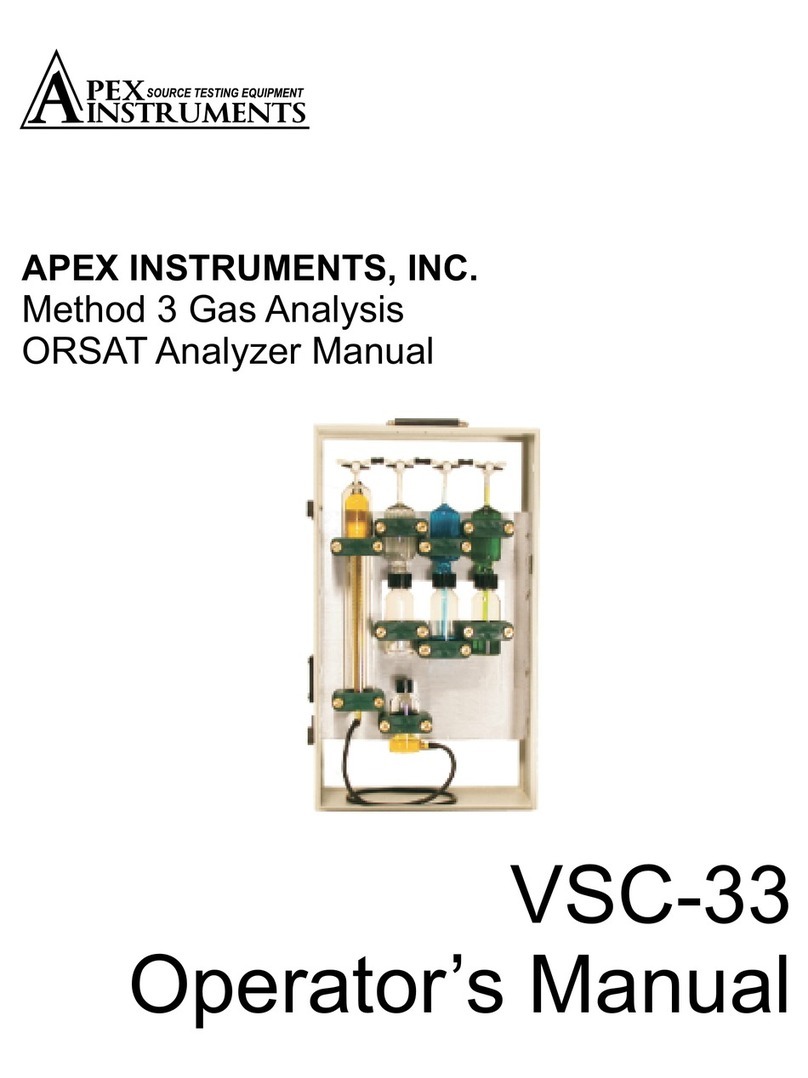
XC-5000
APEX INSTRUMENTS, INC.
1
1
Introduction
1.1
The purpose of this manual is to provide a basic understanding of the Apex Instruments Model XC-5000
Source Sampler Console. Sections of the manual include System Description, Calibration Procedures,
Sampling Procedures as well as Maintenance and Troubleshooting Guides. The manual is based on the
procedures established by the United States Environmental Protection Agency (USEPA) in accordance with
Reference Methods 1 through 5- Determination of Particulate Emissions from Stationary Sources.
1.2
The Apex Instruments XC-5000 Automatic Isokinetic Source Sampling System enables the operator toextract
a sample from a stack isokinetically. The word “isokinetic” is comprised of two Greek root words “Iso” meaning
“the same as” and “Kinet” meaning “relating to motion of material bodies.” Isokinetic Sampling is therefore the
extraction of a gas sample from a gas stream at the same velocity as the gas travels in the stack. Isokinetic
sampling is necessary because of the inertial effect of particulate matter in a gas stream. The isokinetic sampling
ratio, or percent isokinetic, is the ratio of the sample velocity at the inlet of the sampling nozzle to the stack gas
velocity.
1.3
Isokinetic testing requires a thorough understanding of the first five test methods presented in Title 40 Part 60
Appendix A of the Code of Federal Regulations (40CRF60 App A). Method 5 provides the general sampling train
operation protocol, but Methods 1 through 4 prescribe techniques underpinning the sampling activities associated
with Method 5. Together, these methods outline the basic protocols for determining particulate concentrations
and mass emission rates.
Table 1- USEPA Test Methods Applicable to XC-5000 Source Monitoring Console
Method Description
Method 1 Determination of Sampling Location and Traverse Points
Method 2 Determination of Stack Gas Velocity and Volumetric Flow rates
Method 3 Determination of Dry Molecular Weight
Method 4 Determination of Moisture Content in Stack Gases
Method 5 Determination of Particulate Matter Emissions from Stationary Sources
1.4
Unlike manually operated source sampling systems, the XC-5000 eliminates the time consuming effort required
to perform the isokinetic sampling calculations and recording measurement data. The system’s software provides a
form –driven user interface and data management control for:
•
Entering,calculating andstoringdatarequiredtodefine stack traverse points adhering to USEPA Method
1protocols.
•
Configuring and performing USEPA Method 2 Stack Gas Velocity and Volumetric FlowRate
determinations, and performs required calculations and stores collected Method 2 data.
•
Determining Stack Gas Dry Molecular Weight and Concentrations of Oxygen (O2), Nitrogen (N2), Carbon
Dioxide (CO2) and Carbon Monoxide(CO).
•
Determining Moisture Content in StackGases
•
Performing allcalculations necessaryto determine the isokinetic sampling parameters,e.g.,nozzle size,
sample flowrate, test point locations, etc.
1.5
The basic XC-5000 sampling train is easily adapted to test for many other gaseous and particulateparameters
of interest from stationary sources. Parameters of interest may include metals, polychlorinated biphenyls (PCBs),
dioxins/furans, polycyclic aromatic hydrocarbons (PAHs), particle size distributions and an ever-increasing group
of pollutants by adaptations of basic test methods. While the different methods are designated by other US EPA
or agency method numbers, they are variations of Method 5 procedures such as using: different impinger
solutions, organic resin traps, different filter media, sampling temperatures or a range of other alternative
procedures.




























